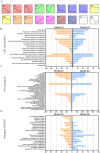Genome-wide identification of MIKC-type genes related to stamen and gynoecium development in Liriodendron
- PMID: 33753780
- PMCID: PMC7985208
- DOI: 10.1038/s41598-021-85927-7
Genome-wide identification of MIKC-type genes related to stamen and gynoecium development in Liriodendron
Abstract
The organogenesis and development of reproductive organs, i.e., stamen and gynoecium, are important floral characteristics that are closely related to pollinators and reproductive fitness. As a genus from Magnoliaceae, Liriodendron has only two relict species: L. chinense and L. tulipifera. Despite the similar flower shapes of these species, their natural seed-setting rates differ significantly, implying interspecies difference in floral organogenesis and development. MADS-box genes, which participate in floral organogenesis and development, remain unexplored in Liriodendron. Here, to explore the interspecies difference in floral organogenesis and development and identify MADS-box genes in Liriodendron, we examined the stamen and gynoecium primordia of the two Liriodendron species by scanning electron microscopy combined with paraffin sectioning, and then collected two types of primordia for RNA-seq. A total of 12 libraries were constructed and 42,268 genes were identified, including 35,269 reference genes and 6,999 new genes. Monoterpenoid biosynthesis was enriched in L. tulipifera. Genome-wide analysis of 32 MADS-box genes was conducted, including phylogenetic trees, exon/intron structures, and conserved motif distributions. Twenty-six genes were anchored on 17 scaffolds, and six new genes had no location information. The expression profiles of MIKC-type genes via RT-qPCR acrossing six stamen and gynoecium developmental stages indicates that the PI-like, AG/STK-like, SEP-like, and SVP-like genes may contribute to the species-specific differentiation of the organogenesis and development of reproductive organs in Liriodendron. Our findings laid the groundwork for the future exploration of the mechanism underlying on the interspecific differences in reproductive organ development and fitness in Liriodendron.
Conflict of interest statement
The authors declare no competing interests.
Figures











Similar articles
-
Genome-Wide Identification MIKC-Type MADS-Box Gene Family and Their Roles during Development of Floral Buds in Wheel Wingnut (Cyclocarya paliurus).Int J Mol Sci. 2021 Sep 19;22(18):10128. doi: 10.3390/ijms221810128. Int J Mol Sci. 2021. PMID: 34576289 Free PMC article.
-
Transcriptomic and microstructural analyses in Liriodendron tulipifera Linn. reveal candidate genes involved in nectary development and nectar secretion.BMC Plant Biol. 2019 Dec 2;19(1):531. doi: 10.1186/s12870-019-2140-0. BMC Plant Biol. 2019. PMID: 31791230 Free PMC article.
-
Genome-Wide Identification and Expression Analysis of R2R3-MYB Family Genes Associated with Petal Pigment Synthesis in Liriodendron.Int J Mol Sci. 2021 Oct 19;22(20):11291. doi: 10.3390/ijms222011291. Int J Mol Sci. 2021. PMID: 34681950 Free PMC article.
-
Changing MADS-Box Transcription Factor Protein-Protein Interactions as a Mechanism for Generating Floral Morphological Diversity.Integr Comp Biol. 2017 Dec 1;57(6):1312-1321. doi: 10.1093/icb/icx067. Integr Comp Biol. 2017. PMID: 28992040 Review.
-
MADS-box genes and floral development: the dark side.J Exp Bot. 2012 Sep;63(15):5397-404. doi: 10.1093/jxb/ers233. Epub 2012 Aug 21. J Exp Bot. 2012. PMID: 22915743 Review.
Cited by
-
Genome-wide investigation of SQUAMOSA promoter binding protein-like genes in Liriodendron and functional characterization of LcSPL2.AoB Plants. 2024 Feb 20;16(2):plae008. doi: 10.1093/aobpla/plae008. eCollection 2024 Feb. AoB Plants. 2024. PMID: 38435968 Free PMC article.
-
Genome-Wide Identification and Expression Analysis of SnRK2 Gene Family in Dormant Vegetative Buds of Liriodendron chinense in Response to Abscisic Acid, Chilling, and Photoperiod.Genes (Basel). 2022 Jul 22;13(8):1305. doi: 10.3390/genes13081305. Genes (Basel). 2022. PMID: 35893042 Free PMC article.
-
Research Progress of CLE and Its Prospects in Woody Plants.Plants (Basel). 2025 May 9;14(10):1424. doi: 10.3390/plants14101424. Plants (Basel). 2025. PMID: 40430988 Free PMC article. Review.
-
Flower development and a functional analysis of related genes in Impatiens uliginosa.Front Plant Sci. 2024 Mar 25;15:1370949. doi: 10.3389/fpls.2024.1370949. eCollection 2024. Front Plant Sci. 2024. PMID: 38590746 Free PMC article.
References
-
- Li HG, Chen L, Liang CY, Huang MR. A case study on provenance testing of tulip tree (Liriodendron spp) Chin. For. Sci. Technol. 2005;19(5):6–13. doi: 10.3969/j.issn.1000-8101.2005.05.005. - DOI
-
- Xu F, Rudall PJ. Comparative floral anatomy and ontogeny in Magnoliaceae. Plant Syst. Evol. 2006;258:1–15. doi: 10.1007/s00606-005-0361-1. - DOI
-
- Wang S, Xie Y. Red List of Endangered Plants in China. Beijing; 2004.
-
- Fan RW, Ye JG, Yin ZF, Gao HG, You LX. Studies on seed development and embryogenesis in Liriodendron chinense (Hemsl) Sary. Acta Bot. Sin. 1992;34(6):437–442.
Publication types
MeSH terms
Substances
LinkOut - more resources
Full Text Sources
Other Literature Sources
Research Materials
Miscellaneous

